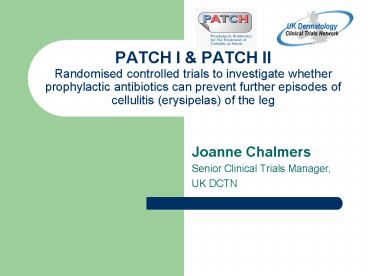PATCH I - PowerPoint PPT Presentation
1 / 16
Title:
PATCH I
Description:
Role of UK Dermatology Clinical Trials Network. PATCH trial design ... Centre of Evidence-based Dermatology. King's Meadow Campus, University of Nottingham ... – PowerPoint PPT presentation
Number of Views:23
Avg rating:3.0/5.0
Title: PATCH I
1
PATCH I PATCH IIRandomised controlled trials
to investigate whether prophylactic antibiotics
can prevent further episodes of cellulitis
(erysipelas) of the leg
- Joanne Chalmers
- Senior Clinical Trials Manager,
- UK DCTN
2
This talk will cover
- Why we are doing the PATCH cellulitis trials
- Role of UK Dermatology Clinical Trials Network
- PATCH trial design
3
Research question
- Does penicillin (250mg bd) taken after an episode
of cellulitis of the leg reduce the risk of
further attacks?
4
Why?
- Cellulitis is common 2-3 of hospital
admissions - Significant cost to NHS (average admission 9
days) - Significant morbidity
- Prophylactic antibiotics for cellulitis sometimes
prescribed but limited evidence supporting this
use - Answers question of importance to clinicians and
patients - First trials to be run through the UK DCTN
...the pain is dreadful, when you stand up it
feels as though your veins are being ripped out.
5
What is the UK DCTN?
- Aim to conduct independent, high-quality,
multi-centre clinical trials - Questions that are important to clinicians and
patients - Network has 260 members
- Dermatologists dermatology nurses
- health services researchers
- patients
- PATCH I II are first DCTN trials
- Shift in NHS towards running trials through
Networks (www.ukcrn.org.uk)
6
How does UK DCTN operate?
- Potential research questions submitted by any
member (vignette) - Discussed by Steering Group
- If approved, outline proposal developed by
Steering Group and Co-ordinating Centre - Full protocol and funding application developed
- Funding bid submitted to external sources
7
The PATCH Study
- Non-commercial studies 2 funding bodies
- Action Medical Research
- The BUPA Foundation
- Randomised, double blind, placebo controlled,
pragmatic study - 660 patients in total
- PATCH I 260
- PATCH II 400
- Multi-centre study in UK and Ireland (20 centres)
- Managed by Kath Foster at UK DCTN co-ordinating
centre - Website www.patchtrial.co.uk
8
Timings
- Approvals finalised in April 2006
- Main REC, regulatory (MHRA)
- Site Specific (local REC), RD
- Southern Ireland IMB Ethics
- First patient recruited in July 2006, most sites
open for recruitment by end of 2006 - Aim to complete recruitment for both studies by
December 2008 - Recruitment running behind schedule currently
9
Primary Objective
- Does prophylaxis reduce the risk of further
attacks of cellulitis?
- PATCH II
- First episode and recurrent cellulitis
- 6 months treatment
- PATCH I
- Recurrent cellulitis only
- 12 months treatment
10
Secondary Objectives
- Does any protection last after the treatment
ceases? - Which baseline factors best predict treatment
success? - Are there any cost savings for the NHS?
- Are there any specific safety issues with regard
to using penicillin in this setting? - What is the impact of cellulitis on
health-related quality of life?
11
Eligibility Criteria
- Reflect clinical practice as far as possible
- Pilot study showed need to keep diagnosis
criteria as open as possible - Diagnosis of cellulitis of the leg
- Warmth tenderness/pain
- Erythema
- Swelling of the leg
- Other signs and symptoms are noted
- Criteria 1-3 must be / have been present if
cellulitis not seen by a dermatologist
12
Main Exclusions
- Prophylactic antibiotics in the previous 6 months
- Allergy to penicillin
- Leg ulcer, surgery or penetrating trauma
- Any concomitant medication that would make
long-term penicillin inappropriate - More than 12 weeks since the start of treatment
for the cellulitis
13
Enrolling patients
- Dermatologist identifies and screens patient for
the study - Co-ordinating centre (CC) will randomise patient
upon receipt of all Consent form, CRF etc. - Web-based randomisation (Nottingham CTSU)
- Medication posted directly to patient from
Pharmacy at Queens Medical Centre, Nottingham - Patient followed up by telephone from CC
- Recruiting dermatologist see patient again if
recurrence of cellulitis occurs
14
Schedule (following consent)
15
In summary
- First UK DCTN trials important question to
answer - Trial is as pragmatic as possible, especially
with regard to eligibility and intervention - Answer will have direct impact on subsequent
clinical practice
16
Contact Information
- PATCH Study Kath Foster
- PATCH Trial Manager
- email kath.foster_at_nottingham.ac.uk
- Tel 0115 846 8626
- UK DCTN Joanne Chalmers
- Senior Trials Manager
- email joanne.chalmers_at_nottingham.ac.uk
- Tel 0115 846 8622
- Carron Layfield
- Network Manager
- email carron.layfield_at_nottingham.ac.uk
- Tel 0115 846 8625
- Membership form in delegate pack hand to
Maggie - Centre of Evidence-based Dermatology
- King's Meadow Campus, University of Nottingham































